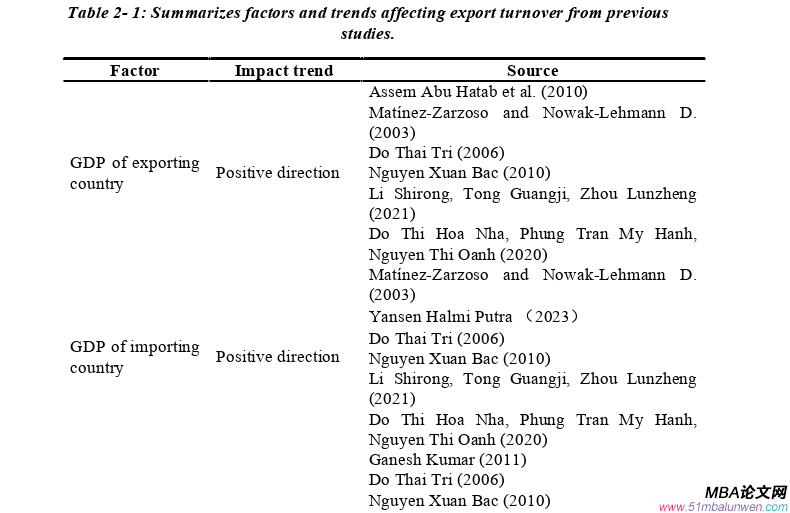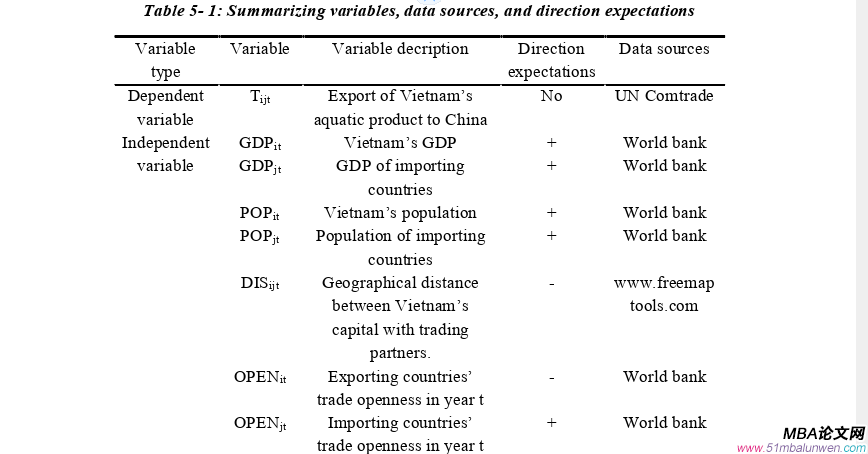越南-中国水产品贸易及其影响因素探讨
本文是一篇国际金融论文,笔者认为当下,全球经济增长变缓,但越南与中国的贸易合作依然坚挺,特别是自2008年越南与中国建立全面战略合作伙伴关系以来,贸易合作更是如火如荼。根据越南海关总署的最新统计,中国一直保持与越南各项产品贸易第一大的地位,成交额占越南总进出口额约25%。 自2020年起,越南成为中国在全球的第六大贸易伙伴。
CHAPTER 1: INTRODUCTION
1.1 Research background
Possessing a coastline of 3,260 km and an exclusive economic zone of 1 million square kilometers, Vietnam is a country with great potential for developing the aquaculture and fishing industry. Vietnam is also a country possessing many diverse aquatic species that are distributed based on differences in geographical and climatic characteristics.The aquatic product sector is currently one of the key economic sectors, playing an important role in the development of Vietnam's economy on an ever-expanding scale. As a pillar industry of Vietnamese economy, fishery accounts for 9%-10% of Vietnamese economic income. Vietnam's aquatic product brand is not only affirmed in the country but also well received by many countries around the world. China is Vietnam's neighbor, and it is also a country with a long coastline and numerous rivers and lakes. At the same time, China is now the world’s largest producer, accounting for about 35% of all global production. According to FAO, it has been the world’s top exporter of aquatic products by volume since 1989, and by value since 2002. China's aquatic products export industry is not only diverse but also large in scope. With advanced aquaculture and processing technology and low labor cost, China has many advantages in the field of aquatic product export industry. In the process of the continuous improvement of China's aquatic product production capacity, the development of China's aquatic product export trade industry has also gradually grown.

国际金融论文怎么写
......................
1.2 Research purpose and significance
1.2.1 Research purpose
In recent years, as one of the largest aquatic product exporters in the world, Vietnam's aquatic product exports account for an increasing proportion of its total exports. China is also a traditional agricultural country, and aquaculture has always been in a leading position in the world. According to the International Trade Centre data, China ranks 2nd in the world aquatic product trade market, and Vietnam ranks 3rd in 2020. Both China and Vietnam have certain comparative advantages in the international aquatic product market. Is there any competition between the two countries? How complementary Vietnam-China aquatic product trade is? In addition to the competitive and complementary relationship, is there a space in the trade of aquatic products between the two countries? What are the factor affecting Vietnam-China aquatic product trade? In view of the above problems, this paper will conduct in-depth research. Therefore, the research proposes several solutions to enhance the competitive capacity of Vietnam’s aquatic products in the world market in general and Chinese market in particular.
1.2.2 Research significance The significance of this research includes two aspects:
(1) Theoretically
Researching Vietnam-China aquatic product trade ca, to some extent, expand the boundaries and enrich the scope and content of research on aquatic products studies around the world, between China and ASEAN as well as between Vietnam and China. At the same time, expand the range of options and solve problems related to aquatic product trade.
Since Vietnam is currently the only country in the world that has successfully achieved economic reforms like China, the two countries can learn from each other in terms of political system and economic development. The aquatic product trade between China and Vietnam not only involves the economic level but also has special significance at the political level. The economic and trade relations between the two countries have always maintained good relationships.
.........................
CHAPTER 2: THEORETICAL FOUNDATION AND LITERATURE REVIEW
2.1 The definition and classification standard of aquatic products
Lin Chutian (2022) defined that aquatic products are a general term for aquatic animal and plant foods and processed products produced in deep sea, shallow beach, and freshwater fisheries. They mainly include two categories, primary aquatic products and processed aquatic products. FAO (2020) demonstrate the significant and growing role of fisheries and aquaculture in providing food, nutrition and employment. According to FAO (2022), aquatic foods are increasingly recognized for their key role in food security and nutrition, not just as a source of protein, but also as a unique and extremely diverse provider of essential omega-3 fatty acids and bioavailable micronutrients.
Since various statistical databases around the world adopt different product classification standards for aquatic products, Duan Yuanyuan, Wang Rong (2009) compared four classification standards including HS, SITC, ISSCAAP, and ISSCFC. Therefore, the researcher found out that among 03 classification standards which are mainly used in trade statics, the International Standard Classification (SITC) of aquatic products of the United Nations Statistical Commission and the International standard statistical classification of fishery commodities (ISSCFC) of aquatic products of the Food and Agriculture Organization of the United Nations (FAO) have the smallest error.
.........................
2.2 Theoretical foundations
2.2.1 Theories of Foreign Trade
(1) Mercantilism
The first theory that explained international trade was the study of mercantilism which favored strict government control on international trade and relied on the principle that countries should produce as much of everything as possible. The mercantilists believed that a nation's wealth could be assessed by the levels of its ownership of precious metals like gold and silver. At that time, exporting goods could obtain currencies like gold and silver, and importing goods would cause these precious metals to leave that country. Import and export always bring prosperity to the country, but international trade according to the rules of the zero-sum game, where one country's gains are always based on other countries' losses. Therefore, the main idea of mercantilism was that it is necessary to maintain a trade surplus which means that exports more than imports for the best benefit of a country. When a country accumulates a lot of gold and silver, its wealth, prestige, and power will also increase. Since then, the mercantilists advocated that the Government intervene deeply in foreign trade, conduct trade protection, and encourage exports. The mercantilism of international trade is highly subjective, often empiric (mainly through British and Dutch commercial activities), does not delve deeply into the study of the inner nature of economic phenomena. A great limitation of mercantilism is that it attached too much importance to money and treats trade as a zero-sum game, this limitation was developed by the theories of Adam Smith and David Ricardo. specified and asserted that trade is a positive-sum game.
................................
CHAPTER 3. THE SITUATION OF VIETNAM-CHINA AQUATIC PRODUCT TRADE ....................... 28
3.1 The situation of aquatic products in Vietnam ........................ 28
3.1.1 Overview ..................................... 28
3.1.2 Production ................................ 29
CHAPTER 4: COMPETITIVENESS AND COMPLEMENTARITY STUDIES ON AQUATIC PRODUCT TRADE BETWEEN VIETNAM AND CHINA ...... 50
4.1.A competitiveness study on the trade of aquatic products between China and Vietnam .............................. 50
4.1.1 Trade Competitiveness Index ............................. 50
4.1.2 Revealed Comparative Advantage Index ......................... 54
CHAPTER 5: ANALYS OF FACTORS INFLUENCING TO VIETNAM-CHINA AQUATIC PRODUCT TRADE ........... 63
5.1 Model selection and research method .......................... 63
5.1.1. Gravity model setting ................................. 63
5.1.2 Data source and statistics ................................. 65
CHAPTER 5: ANALYS OF FACTORS INFLUENCING TO VIETNAM-CHINA AQUATIC PRODUCT TRADE
5.1 Model selection and research method
5.1.1. Gravity model setting
The application of the gravity model to international trade research has been introduced in various forms in previous studies.
Specifically for the case of Vietnam, based on the analysis of model theory and the current status of aquatic product export situation, the study will apply a model with a similar form to the model based on the model. model proposed by Bergstrand (1985). The model will include basic variables such as economic scale of exporting and importing countries (GDP), population of exporting and importing countries (POP), geographical distance DIS, economic distance EDIS, real exchange rate RER and dummy variables: common land border, WTO, ACFTA.

国际金融论文参考
............................
CHAPTER 6: CONCLUSION AND RECOMMENDATION
6.1 Conclusion
This article first analyzes the current trade situation of aquatic products between Vietnam and China. Secondly, it analyzes the competitiveness and complementarity of the trade of aquatic product between Vietnam and China. Finally, selects the export data of Vietnam’s aquatic product to China from 2002 to 2022, and uses the gravity model to empirically test the determinants and trade efficiency of aquatic product trade between Vietnam and China. The main conclusions are as follows:
Firstly, the trade of aquatic products between Vietnam and China has continuously increased over the years. While the development of fishing and aquaculture activities has created a solid foundation for Vietnam's aquatic product export growth, China's aquatic product output mainly comes from aquaculture due to the Chinese government's fishing restriction policies. Especially since the fishing restriction policy took effect in 2017, aquaculture output also increased while fishing output gradually decreased year by year. The proportion of catching production over total aquatic product output decreased from 33% to 23% in 2022. While aquatic products exported by Vietnam are mainly primary and semi-processed products (SITC 034, SITC 036), processed products are the main product group in the structure of Chinese aquatic product export. Vietnam imports from China mainly crustaceans, mollucscs and its proccessed foods (SITC 036, SITC 0372). Prior to 2008, the proportion of imported crustaceans, mollucscs, fresh, chilled, frozen, salted, etc (SITC 036) accounted for over 60% of Vietnam's total aquatic import turnover from China. From 2008 onwards, Vietnam mainly imported fish products (SITC 034) with a proportion of over 60%.
reference(omitted)


